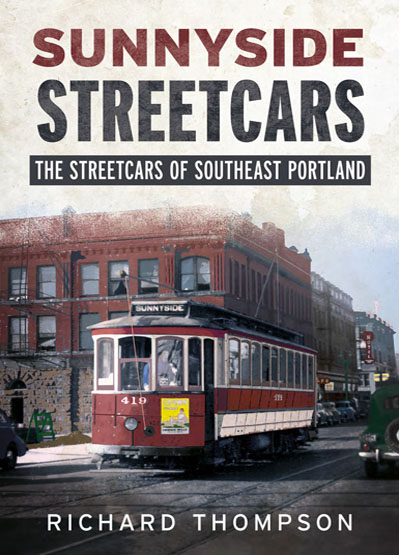 reetcars played
a key role in the frenzy of development that
followed completion of the first bridges across
the Willamette River in Portland in 1887. As
carlines radiated eastward, a revolutionary
shift in population saw suburban neighborhoods
like Sunnyside spring up overnight. In 1888, the
first steam streetcars expanded the city of East
Portland beyond the limits imposed by
horse-drawn transportation. Within a year,
"motor" lines were running north and south of
Mount Tabor and local entrepreneurs, prompted by
opposition to locomotives rumbling over city
streets, were experimenting with new-fangled
battery, gasoline and electric-powered
streetcars. In 1889, Southeast Portland
residents raised their own money to fund one of
the first electric street railways in the
country. By 1891, rival companies had merged to
form the largest street railway system in the
West. The process would continue into the early
twentieth century, as Portland built the third
largest system of its kind in the United States.
Most of its carlines would serve Southeast
Portland, operating from the city's largest
carbarn complex. This is the colorful story of
those sixteen liens, from the first steam dummy
to Sunnyside in 1888 to the last trolleys to
Mount Tabor and Montavilla sixty years later.
reetcars played
a key role in the frenzy of development that
followed completion of the first bridges across
the Willamette River in Portland in 1887. As
carlines radiated eastward, a revolutionary
shift in population saw suburban neighborhoods
like Sunnyside spring up overnight. In 1888, the
first steam streetcars expanded the city of East
Portland beyond the limits imposed by
horse-drawn transportation. Within a year,
"motor" lines were running north and south of
Mount Tabor and local entrepreneurs, prompted by
opposition to locomotives rumbling over city
streets, were experimenting with new-fangled
battery, gasoline and electric-powered
streetcars. In 1889, Southeast Portland
residents raised their own money to fund one of
the first electric street railways in the
country. By 1891, rival companies had merged to
form the largest street railway system in the
West. The process would continue into the early
twentieth century, as Portland built the third
largest system of its kind in the United States.
Most of its carlines would serve Southeast
Portland, operating from the city's largest
carbarn complex. This is the colorful story of
those sixteen liens, from the first steam dummy
to Sunnyside in 1888 to the last trolleys to
Mount Tabor and Montavilla sixty years later.
Richard Thompson is a native Oregonian whose family
first settled in Linn County in the 1880s. His
interest in street railways and interurbans began as
a boy, when his grandmother took him for rides on
Portland's last streetcars. Now a semi-retired
writer and consultant, Thompson holds a master's
degree from the University of Oregon. He has worked
as a historical museum director, college instructor,
school librarian, archivist, educational
technologist and trolley crew coordinator. He
is the author of seven on railway history and has
appeared in several documentaries, including Streetcar
City, produced by Oregon Public
Broadcasting.

